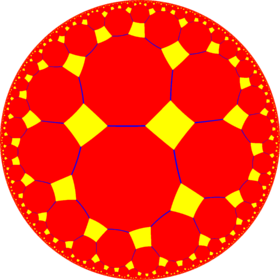| Truncated order-4 hexagonal tiling | |
|---|---|
 Poincaré disk model of the hyperbolic plane | |
| Type | Hyperbolic uniform tiling |
| Vertex configuration | 4.12.12 |
| Schläfli symbol | t{6,4} tr{6,6} or |
| Wythoff symbol | 2 4 | 6 2 6 6 | |
| Coxeter diagram | |
| Symmetry group | [6,4], (*642) [6,6], (*662) |
| Dual | Order-6 tetrakis square tiling |
| Properties | Vertex-transitive |
In geometry, the truncated order-4 hexagonal tiling is a uniform tiling of the hyperbolic plane. It has Schläfli symbol of t{6,4}. A secondary construction tr{6,6} is called a truncated hexahexagonal tiling with two colors of dodecagons.
Constructions
editThere are two uniform constructions of this tiling, first from [6,4] kaleidoscope, and a lower symmetry by removing the last mirror, [6,4,1+], gives [6,6], (*662).
| Name | Tetrahexagonal | Truncated hexahexagonal |
|---|---|---|
| Image | ||
| Symmetry | [6,4] (*642) |
[6,6] = [6,4,1+] (*662) = |
| Symbol | t{6,4} | tr{6,6} |
| Coxeter diagram |
Dual tiling
edit| The dual tiling, order-6 tetrakis square tiling has face configuration V4.12.12, and represents the fundamental domains of the [6,6] symmetry group. | |
Related polyhedra and tiling
edit| *n42 symmetry mutation of truncated tilings: 4.2n.2n | |||||||||||
|---|---|---|---|---|---|---|---|---|---|---|---|
| Symmetry *n42 [n,4] |
Spherical | Euclidean | Compact hyperbolic | Paracomp. | |||||||
| *242 [2,4] |
*342 [3,4] |
*442 [4,4] |
*542 [5,4] |
*642 [6,4] |
*742 [7,4] |
*842 [8,4]... |
*∞42 [∞,4] | ||||
| Truncated figures |
|||||||||||
| Config. | 4.4.4 | 4.6.6 | 4.8.8 | 4.10.10 | 4.12.12 | 4.14.14 | 4.16.16 | 4.∞.∞ | |||
| n-kis figures |
|||||||||||
| Config. | V4.4.4 | V4.6.6 | V4.8.8 | V4.10.10 | V4.12.12 | V4.14.14 | V4.16.16 | V4.∞.∞ | |||
| Uniform tetrahexagonal tilings | |||||||||||
|---|---|---|---|---|---|---|---|---|---|---|---|
| Symmetry: [6,4], (*642) (with [6,6] (*662), [(4,3,3)] (*443) , [∞,3,∞] (*3222) index 2 subsymmetries) (And [(∞,3,∞,3)] (*3232) index 4 subsymmetry) | |||||||||||
| = = = |
= |
= = = |
= |
= = = |
= |
||||||
| {6,4} | t{6,4} | r{6,4} | t{4,6} | {4,6} | rr{6,4} | tr{6,4} | |||||
| Uniform duals | |||||||||||
| V64 | V4.12.12 | V(4.6)2 | V6.8.8 | V46 | V4.4.4.6 | V4.8.12 | |||||
| Alternations | |||||||||||
| [1+,6,4] (*443) |
[6+,4] (6*2) |
[6,1+,4] (*3222) |
[6,4+] (4*3) |
[6,4,1+] (*662) |
[(6,4,2+)] (2*32) |
[6,4]+ (642) | |||||
| = |
= |
= |
= |
= |
= |
||||||
| h{6,4} | s{6,4} | hr{6,4} | s{4,6} | h{4,6} | hrr{6,4} | sr{6,4} | |||||
| Uniform hexahexagonal tilings | ||||||
|---|---|---|---|---|---|---|
| Symmetry: [6,6], (*662) | ||||||
| = = |
= = |
= = |
= = |
= = |
= = |
= = |
| {6,6} = h{4,6} |
t{6,6} = h2{4,6} |
r{6,6} {6,4} |
t{6,6} = h2{4,6} |
{6,6} = h{4,6} |
rr{6,6} r{6,4} |
tr{6,6} t{6,4} |
| Uniform duals | ||||||
| V66 | V6.12.12 | V6.6.6.6 | V6.12.12 | V66 | V4.6.4.6 | V4.12.12 |
| Alternations | ||||||
| [1+,6,6] (*663) |
[6+,6] (6*3) |
[6,1+,6] (*3232) |
[6,6+] (6*3) |
[6,6,1+] (*663) |
[(6,6,2+)] (2*33) |
[6,6]+ (662) |
| = | = | = | ||||
| h{6,6} | s{6,6} | hr{6,6} | s{6,6} | h{6,6} | hrr{6,6} | sr{6,6} |
Symmetry
editThe dual of the tiling represents the fundamental domains of (*662) orbifold symmetry. From [6,6] (*662) symmetry, there are 15 small index subgroup (12 unique) by mirror removal and alternation operators. Mirrors can be removed if its branch orders are all even, and cuts neighboring branch orders in half. Removing two mirrors leaves a half-order gyration point where the removed mirrors met. In these images fundamental domains are alternately colored black and white, and mirrors exist on the boundaries between colors. The subgroup index-8 group, [1+,6,1+,6,1+] (3333) is the commutator subgroup of [6,6].
Larger subgroup constructed as [6,6*], removing the gyration points of (6*3), index 12 becomes (*333333).
The symmetry can be doubled to 642 symmetry by adding a mirror to bisect the fundamental domain.
| Small index subgroups of [6,6] (*662) | |||||||||||
|---|---|---|---|---|---|---|---|---|---|---|---|
| Index | 1 | 2 | 4 | ||||||||
| Diagram | |||||||||||
| Coxeter | [6,6] |
[1+,6,6] = |
[6,6,1+] = |
[6,1+,6] = |
[1+,6,6,1+] = |
[6+,6+] | |||||
| Orbifold | *662 | *663 | *3232 | *3333 | 33× | ||||||
| Direct subgroups | |||||||||||
| Diagram | |||||||||||
| Coxeter | [6,6+] |
[6+,6] |
[(6,6,2+)] |
[6,1+,6,1+] = = = = |
[1+,6,1+,6] = = = = | ||||||
| Orbifold | 6*3 | 2*33 | 3*33 | ||||||||
| Direct subgroups | |||||||||||
| Index | 2 | 4 | 8 | ||||||||
| Diagram | |||||||||||
| Coxeter | [6,6]+ |
[6,6+]+ = |
[6+,6]+ = |
[6,1+,6]+ = |
[6+,6+]+ = [1+,6,1+,6]+ = = = | ||||||
| Orbifold | 662 | 663 | 3232 | 3333 | |||||||
| Radical subgroups | |||||||||||
| Index | 12 | 24 | |||||||||
| Diagram | |||||||||||
| Coxeter | [6,6*] |
[6*,6] |
[6,6*]+ |
[6*,6]+ | |||||||
| Orbifold | *333333 | 333333 | |||||||||
References
edit- John H. Conway, Heidi Burgiel, Chaim Goodman-Strauss, The Symmetries of Things 2008, ISBN 978-1-56881-220-5 (Chapter 19, The Hyperbolic Archimedean Tessellations)
- "Chapter 10: Regular honeycombs in hyperbolic space". The Beauty of Geometry: Twelve Essays. Dover Publications. 1999. ISBN 0-486-40919-8. LCCN 99035678.
